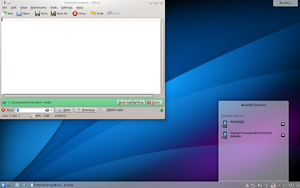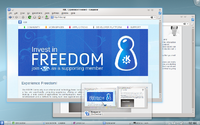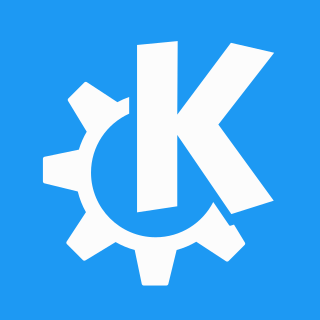
KDE is an international free software community that develops free and open-source software. As a central development hub, it provides tools and resources that allow collaborative work on this kind of software. Well-known products include the Plasma Desktop, Frameworks and a range of cross-platform applications like Krita or digiKam designed to run on Unix and Unix-like desktops, Microsoft Windows and Android.
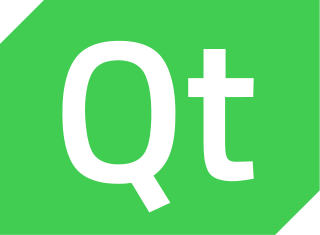
Qt is a widget toolkit for creating graphical user interfaces as well as cross-platform applications that run on various software and hardware platforms such as Linux, Windows, macOS, Android or embedded systems with little or no change in the underlying codebase while still being a native application with native capabilities and speed.
In computing, a desktop environment (DE) is an implementation of the desktop metaphor made of a bundle of programs running on top of a computer operating system that share a common graphical user interface (GUI), sometimes described as a graphical shell. The desktop environment was seen mostly on personal computers until the rise of mobile computing. Desktop GUIs help the user to easily access and edit files, while they usually do not provide access to all of the features found in the underlying operating system. Instead, the traditional command-line interface (CLI) is still used when full control over the operating system is required.
freedesktop.org (fd.o) is a project to work on interoperability and shared base technology for free-software desktop environments for the X Window System (X11) and Wayland on Linux and other Unix-like operating systems. It was founded by Havoc Pennington, a GNOME developer working for Red Hat in March 2000. The project's servers are hosted by Portland State University, sponsored by Hewlett-Packard, Intel, and Google.

Window Maker is a free and open-source window manager for the X Window System, allowing graphical applications to be run on Unix-like operating-systems. It is designed to emulate NeXTSTEP's GUI as an OpenStep-compatible environment. Window Maker is part of the GNU Project.

Bluecurve is a desktop theme for GNOME and KDE created by the Red Hat Artwork project. The main aim of Bluecurve was to create a consistent look throughout the Linux environment, and provide support for various Freedesktop.org desktop standards. It has been used in Red Hat Linux since version 8.0, and Fedora Core.
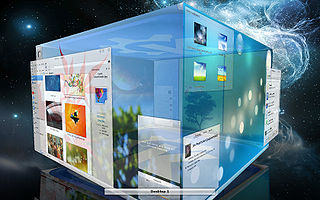
KWin is a window manager for the X Window System and also becoming a Wayland compositor. It is released as a part of KDE Plasma 5, for which it is the default window manager. KWin can also be used on its own or with other desktop environments.
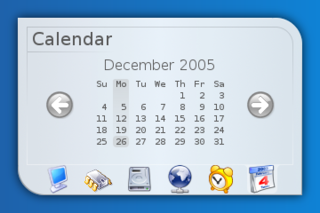
SuperKaramba is a tool, a so-called widget engine, that allows the creation of functionality enhancement modules on the KDE desktop. The desktop widgets are usually embedded directly into the background and do not disturb the normal view of the desktop. The use of SuperKaramba is not limited to KDE, but certain libraries from KDE are required. SuperKaramba had been included in KDE since version 3.5. SuperKaramba is similar to gDesklets for GNOME. The name derives from Portuguese and Spanish super caramba, meaning approximately "super wow" or "super cool".

KDE Software Compilation 4 was the only series of the so-called KDE Software Compilation, first released in January 2008 and the last release being 4.14.3 released in November 2014. It was the follow-up to K Desktop Environment 3. Following KDE SC 4, the compilation was broken up into basic framework libraries, desktop environment and applications, which are termed KDE Frameworks 5, KDE Plasma 5 and KDE Applications, respectively.
Nuvola is a free software icon set under the GNU LGPL 2.1 license, created by David Vignoni. Originally created for desktop environments like KDE and GNOME, it is also available in packages for Windows and Mac. The final version, 1.0, contains almost 600 icons. The default set is in the PNG graphics format; an SVG version is also available.
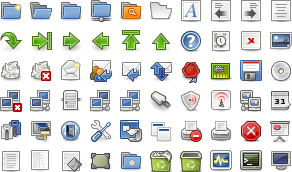
The Tango Desktop Project was an open-source initiative to create a set of design guidelines and to provide a consistent user experience for applications on desktop environments. The project created a set of icons known as the Tango Icon Library and that were described as a "proof of concept". The Tango Desktop Project was a project of freedesktop.org, and was closely linked with other freedesktop.org guidelines, such as the Standard Icon Theming Specification.

Compiz is a compositing window manager for the X Window System, using 3D graphics hardware to create fast compositing desktop effects for window management. Effects, such as a minimization animation or a cube workspace, are implemented as loadable plugins. Because it conforms to the ICCCM conventions, Compiz can be used as a substitute for the default Mutter or Metacity, when using GNOME Panel, or KWin in KDE Plasma Workspaces. Internally Compiz uses the OpenGL library as the interface to the graphics hardware.

KDE Plasma 4 was the fourth generation of the KDE workspace environments. It consisted of three workspaces, each targeting a certain platform: Plasma Desktop for traditional desktop PCs and notebooks, Plasma Netbook for netbooks, and Plasma Active for tablet PCs and similar devices.

GNOME Shell is the graphical shell of the GNOME desktop environment starting with version 3, which was released on April 6, 2011. It provides basic functions like launching applications, switching between windows and is also a widget engine. GNOME Shell replaced GNOME Panel and some ancillary components of GNOME 2.

The KDE Software Compilation was an umbrella term for the desktop environment plus a range of included applications produced by KDE. From its 1.0 release in July 1998 until the release of version 4.4 in February 2010, the Software Compilation was simply known as KDE, which stood for K Desktop Environment until the rebrand. The then called KDE SC was used from 4.4 onward until the final release 4.14 in July 2014. It consisted of the KDE Plasma 4 desktop and those KDE applications, whose development teams chose to follow the Software Compilation's release schedule. After that, the KDE SC was split into three separate product entities: KDE Plasma, KDE Frameworks and KDE Applications, each with their own independent release schedules.
Nuno Pinheiro is a Portuguese graphic designer and illustrator. He specializes in iconography, themes and user interface design. Pinheiro's works include general illustrations, UI design, Web design, corporate design, as well as other works in creative areas.
Fedora is a popular Linux distribution developed by the community-supported Fedora Project and is sponsored by Red Hat. Fedora attempts to maintain a six-month release schedule, offering new versions in May and November, although some releases have experienced minor delays.

The Trinity Desktop Environment (TDE) is a complete software desktop environment designed for Linux and Unix-like operating systems, intended for computer users preferring a traditional desktop model, and is free/libre software. Born as a fork of KDE 3.5 back in 2010, it was originally created by Timothy Pearson, who had coordinated Kubuntu remixes featuring KDE 3.5 after Kubuntu switched to KDE Plasma 4.

KDE Plasma 5 is the fifth and current generation of the graphical workspaces environment created by KDE primarily for Linux systems. KDE Plasma 5 is the successor of KDE Plasma 4 and was first released on 15 July 2014.

KDE Projects are projects maintained by the KDE community, a group of people developing and advocating free software for everyday use, for example KDE Plasma and KDE Frameworks or applications such as Amarok, Krita or Digikam. There are also non-coding projects like designing the Breeze desktop theme and iconset, which is coordinated by KDE's VisualDesignGroup. Even non-Qt applications like GCompris, which started as a GTK-based application, or web-based projects like WikiToLearn are officially part of KDE.

